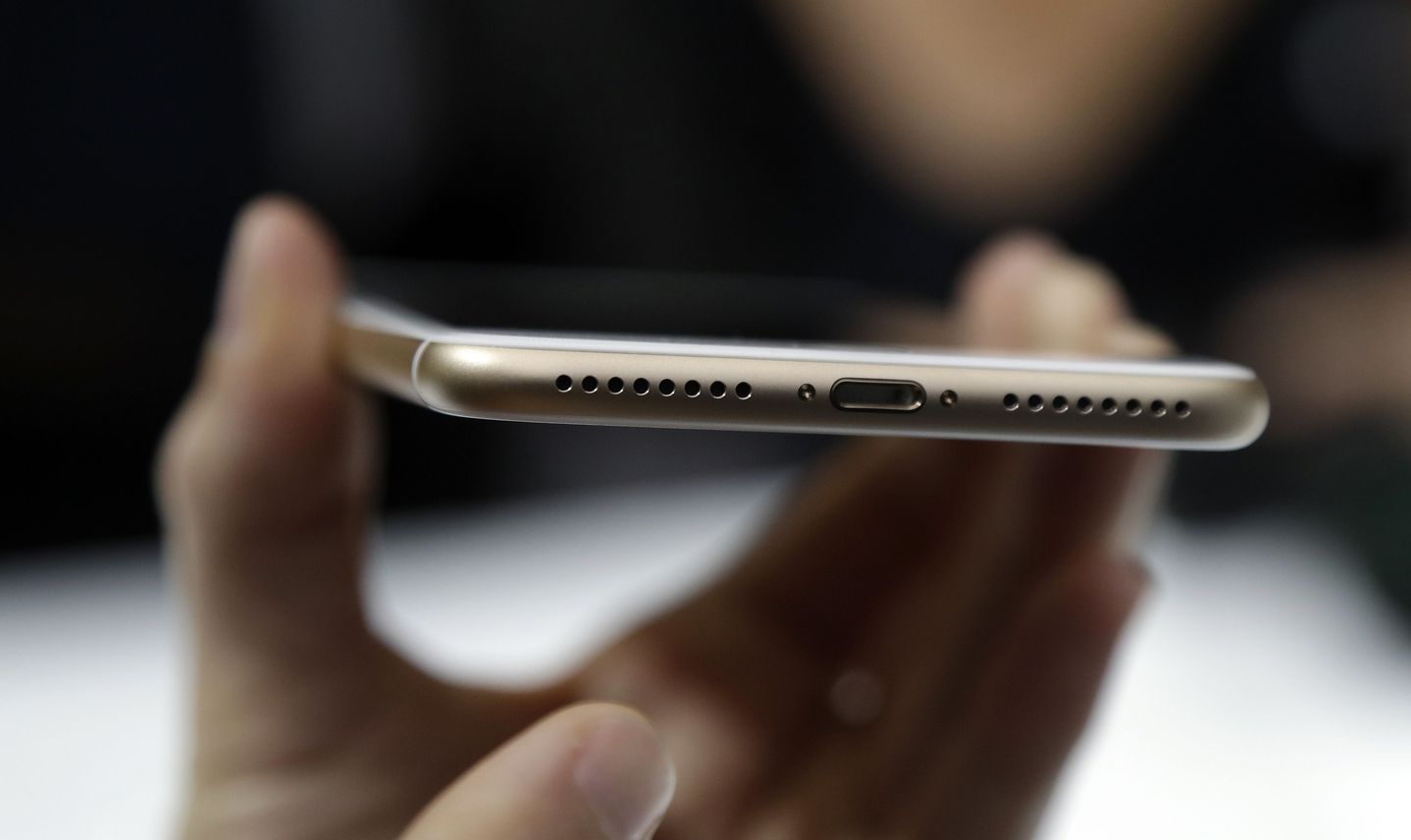
Apple’s abandonment of hardware standard signals aggressive new IP strategy
A demonstrator displays the bottom of the iPhone 7, which features a new microphone grille, where previous iPhones’ headphone jacks were once located.
One of the most newsworthy updates to Apple Inc.’s recently released iPhone 7 is the wholesale elimination of the 3.5mm analog headphone jack, a connector included on virtually every piece of portable media equipment sold since the mid-1960s.
iPhone 7 owners instead have three options through which to listen to music or video using headphones: wirelessly, using Bluetooth; “dongled,” using an adapter to bridge between 3.5mm headphones and Apple’s proprietary ‘Lightning’ port (the same port through which iPhone owners charge and sync their devices); or wired, using headphones with Lightning connectors built-in.
Suffice to say, the options available to iPhone owners are more confusing now than they were previously.
Technological experts have fiercely debated the merits of eliminating the analog headphone jack in favour of digital standards. Those applauding Apple’s decision view it as a logical step toward a wireless future wherein charging, syncing, and listening are performed without the need for cables at all.
Those criticizing Apple’s decision view it as an inconvenient and unjustifiable move away from an established industry standard.
Little, however, has been written about the legal implications of Apple’s abandonment of the otherwise ubiquitous 3.5mm port. This article aims to briefly explore a few ways in which Apple’s elimination of the headphone jack may serve to bolster the value of its intellectual property while disadvantaging average consumers. I will focus on two areas in particular: the proprietary Lightning connector and the potential imposition of more robust digital rights management for music and movies.
Apple’s move away from the headphone jack is a move from an open standard (the headphone jack is not and cannot be patented) to a closed one, owned and controlled by Apple. If a headphone manufacturer wants to bring a pair of Lightning headphones to market, it must register for Apple’s ‘MFi’ program, a licensing framework with which third parties must comply in order to legally distribute and sell the hardware connectors and components necessary to operate their devices.
Apple’s website is clear: “accessories that connect to an Apple device through [a 3.5mm] headphone jack and do not use any MFi licensed technology” are not subject to the MFi program. On the other hand, Lightning connectors and Audio Modules—devices both needed to power Lightning headphones—are.
So, while the 3.5mm headphone jack standard utilized a combination of public domain technology and componentswithin the iPhone itself to transmit sound—including digital-to-analog signal converters, amplifiers, and power regulators—the Lightning standard requires headphone manufacturers to pay for the ability to incorporate Apple’s patented Lightning technology into their own devices.
Lightning technologyalso enables digital rights holders the ability to introduce new forms of copy protection, or digital rights management (“DRM,”) to fortify their IP interests.While DRM has been eliminated from Apple’s iTunes music downloading service, Apple continues to employ various types of DRM to manage movie and television downloads as well as theApple Music streaming service.
The Lightning standard provides Apple and other rights holders a powerful means through which to enforce new types of DRM by limiting playback through unauthorized devices or distorting the soundquality of files they deem questionable, and could be used to force consumers toward particular media distribution outlets.
Similar such technology has been employed through Intel’s High-bandwidth Digital Content Protection system and Verance’s Cina via copy management system, which has been incorporated within all consumer Blu-ray Disc players sold since 2012. Both use digital connection standards (Display Port, DVI, HDMI, and others) to decrypt, examine, flag, and limit access to unauthorized media in real time.
Robust DRM of that sort cannot be exploited through the physical hardware of the analog headphone jack. With Lightning, however, deep hardware-software DRM integration is a looming and increasingly likely possibility.
Apple’s move toward a proprietary digital audio standard—the first of its kind ever introduced—signals the introduction of a vigorous and sophisticated intellectual property strategy that aims to control and monetize the hardware connected to its devices as well as the sound that comes out of its devices.
By leveraging its market penetration, history of innovation, and wide-ranging intellectual property profile, Apple has taken steps to influence the technological landscape through limiting consumers’ access to portable media.
James A. Hayes is a third-year student at Osgoode Hall Law School
